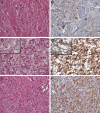Activating mutations in BRAF characterize a spectrum of pediatric low-grade gliomas
- PMID: 20156809
- PMCID: PMC2940652
- DOI: 10.1093/neuonc/noq007
Activating mutations in BRAF characterize a spectrum of pediatric low-grade gliomas
Abstract
In the present study, DNA from 27 grade I and grade II pediatric gliomas, including ganglioglioma, desmoplastic infantile ganglioglioma, dysembryoplastic neuroepithelial tumor, and pleomorphic xanthoastrocytoma was analyzed using the Illumina 610K Beadchip SNP-based oligonucleotide array. Several consistent abnormalities, including gain of chromosome 7 and loss of 9p21 were observed. Based on our previous studies, in which we demonstrated BRAF mutations in 3 gangliogliomas, 31 tumors were screened for activating mutations in exons 11 and 15 of the BRAF oncogene or a KIAA1549-BRAF fusion product. There were no cases with a KIAA1549-BRAF fusion. A BRAF V600E mutation was detected in 14 of 31 tumors, which was not correlated with any consistent pattern of aberrations detected by the SNP array analysis. Tumors were also screened for mutations in codon 132 in exon 4 of IDH1, exons 2 and 3 of KRAS, and exons 2-9 of TP53. No mutations in KRAS or TP53 were identified in any of the samples, and there was only 1 IDH1 R132H mutation detected among the sample set. BRAF mutations constitute a major genetic alteration in this histologic group of pediatric brain tumors and may serve as a molecular target for biologically based inhibitors.
Figures



Similar articles
-
Analysis of IDH1-R132 mutation, BRAF V600 mutation and KIAA1549-BRAF fusion transcript status in central nervous system tumors supports pediatric tumor classification.J Cancer Res Clin Oncol. 2016 Jan;142(1):89-100. doi: 10.1007/s00432-015-2006-2. Epub 2015 Jun 27. J Cancer Res Clin Oncol. 2016. PMID: 26115961 Free PMC article.
-
Diagnostic application of high resolution single nucleotide polymorphism array analysis for children with brain tumors.Cancer Genet. 2014 Apr;207(4):111-23. doi: 10.1016/j.cancergen.2014.03.002. Epub 2014 Mar 15. Cancer Genet. 2014. PMID: 24767714 Free PMC article.
-
The differential diagnosis of pilocytic astrocytoma with atypical features and malignant glioma: an analysis of 16 cases with emphasis on distinguishing molecular features.J Neurooncol. 2013 Dec;115(3):477-86. doi: 10.1007/s11060-013-1249-5. Epub 2013 Sep 21. J Neurooncol. 2013. PMID: 24057326
-
BRAF alterations in primary brain tumors.Discov Med. 2018 Aug;26(141):51-60. Discov Med. 2018. PMID: 30265855 Review.
-
Prevalence of BRAFV600 in glioma and use of BRAF Inhibitors in patients with BRAFV600 mutation-positive glioma: systematic review.Neuro Oncol. 2022 Apr 1;24(4):528-540. doi: 10.1093/neuonc/noab247. Neuro Oncol. 2022. PMID: 34718782 Free PMC article.
Cited by
-
Expression profiles of 151 pediatric low-grade gliomas reveal molecular differences associated with location and histological subtype.Neuro Oncol. 2015 Nov;17(11):1486-96. doi: 10.1093/neuonc/nov045. Epub 2015 Mar 29. Neuro Oncol. 2015. PMID: 25825052 Free PMC article.
-
Anaplastic PXA in adults: case series with clinicopathologic and molecular features.J Neurooncol. 2013 Jan;111(1):59-69. doi: 10.1007/s11060-012-0991-4. Epub 2012 Oct 25. J Neurooncol. 2013. PMID: 23096133 Free PMC article.
-
Hodgkin's lymphoma in an adolescent previously treated with surgical resection of third ventricular juvenile pilocytic astrocytoma.BMJ Case Rep. 2015 Jun 25;2015:bcr2015209343. doi: 10.1136/bcr-2015-209343. BMJ Case Rep. 2015. PMID: 26113587 Free PMC article.
-
Pathologic and molecular aspects of anaplasia in circumscribed gliomas and glioneuronal tumors.Brain Tumor Pathol. 2019 Apr;36(2):40-51. doi: 10.1007/s10014-019-00336-z. Epub 2019 Mar 11. Brain Tumor Pathol. 2019. PMID: 30859342 Free PMC article. Review.
-
Analysis of KIAA1549-BRAF fusion gene expression and IDH1/IDH2 mutations in low grade pediatric astrocytomas.J Neurooncol. 2014 Apr;117(2):235-42. doi: 10.1007/s11060-014-1398-1. Epub 2014 Feb 17. J Neurooncol. 2014. PMID: 24532263
References
-
- Louis DN, Ohgaki H, Wiestler OD, Cavenee WK. Lyon: IARC; 2007. WHO Classification of Tumors of the Central Nervous System. - PubMed
-
- Sievert AJ, Jackson EM, Gai X, et al. Duplication of 7q34 in pediatric low-grade astrocytomas detected by high-density single nucleotide polymorphism-based genotype arrays results in a novel BRAF fusion gene. Brain Pathol. 2008 doi:10.1111/j1750-3639.2008.00225.x. - DOI - PMC - PubMed
-
- Forshew T, Tatvossian RG, Lawson ARJ, et al. Activation of the ERK/MAPK pathway: a signature genetic defect in posterior fossa pilocytic astrocytomas. J Pathol. 2009 doi:10.1002/path.2558. - DOI - PubMed
-
- Peyssonnaux C, Eychene A. The Raf/MEK/ERK pathway: new concepts of activation. Biol Cell. 2001;93:53–62. - PubMed
Publication types
MeSH terms
Substances
Grants and funding
LinkOut - more resources
Full Text Sources
Other Literature Sources
Medical
Research Materials
Miscellaneous

